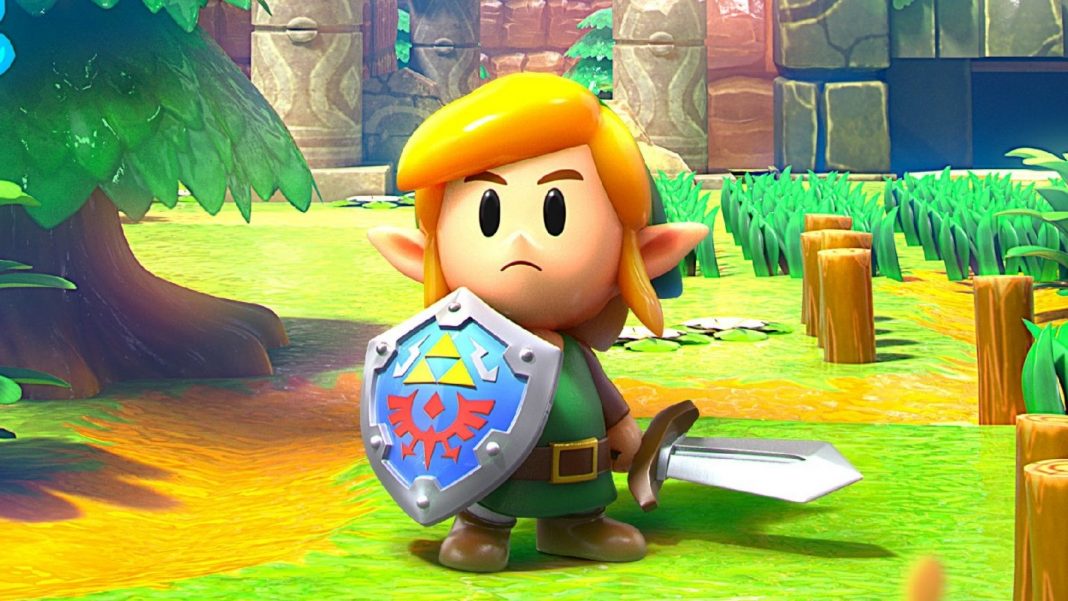Walk up to any fan of The Legend of Zelda franchise and ask them what their favorite game of the series might be. Odds are good that they will respond with either Ocarina of Time or A Link to the Past. If you ask enough people you will inevitably run into some hipster who tries to stand out from the crowd by claiming The Legend of Zelda: Link’s Awakening has always been their favorite.
I am not one of those people. While Zelda was (and still is) my faavorite video game franchise of all time, I despised the original Game Boy hardware with its blurry screen. Because of that, I missed out on a large part of the Game Boy library until the mid-200s when I got my hands on a Game Boy SP. That system breathed new life into Nintendo’s handheld library and it was then that I fell in love with the quirky and offbeat Link’s Awwakening.
And now, twenty-six years after its original release, Nintendo has spruced what is arguably the best game on the Game Boy and released it on the Switch. Does The Legend of Zelda: Link’s Awakening hold up after nearly three decades? Let’s put on our green caps and find out.
Story
Link’s Awakening is the first game in the series to buck the trend of having to rescue a princess named Zelda. She is no where to be found in this game (though to be fair one character in particular does bear a striking resemblance to the titular Princess.) In fact, the familiar setting of Hyrule lies far away as Link finds himself stranded on a mysterious island after a massive storm. It seems that the only way Link can get off of Koholint Island and back to Hyrule is by waking an entity known as the Wind Fish who is asleep in a giant egg on top of the island’s highest mountain. To do this, Link must gather eight musical instruments hidden across the island to play the melody known as the Ballad of the Wind Fish. Unfortunately, the island itself is a dream of the Wind Fish and the monsters who live on it are determined to keep the Wind Fish in a state of slumber.
While A Link to the Past offered an epic adventure across a sprawling kingdom, Link’s Awakening is a smaller and more intimate tale. While it may not offer the scope of its predecessor, this game does provide a more detailed look at the characters who live on the island and believe me – the word “quirky” does not even begin to describe these inhabitants. From the alligator with a preference for canned food to the little Chain Chomp with a sense of style to the old woman who uses the photo of a certain younger princess in order to catfish a potential love interest, the characters in this game are a far cry from the generic villagers of earlier Zelda games. Even the enemies have a motivation for their actions aside from taking over the world. From their point of view the future of their existence is at risk. They are fighting for their lives and that is something we did not see too often in video games from the early 90’s.
And then we have the ending! Don’t worry, I am not going to spoil the story here but Link’s Awakening offers the first truly bittersweet conclusion of the entire franchise and it holds up beautifully today.
Graphics
The original Link’s Awakening used graphics inspired by the previous year’s entry, A Link to the Past albeit designed for a monochromatic screen. While lacking the range of color or special effects of its 16-bit cousin, the visuals in Link’s Awakening were completely serviceable. It was never an issue to identify an enemy as opposed to an NPC you could talk to or an item you could pick up.
In the latest version of Link’s Awakening, the developers have opted for what they refer to as a “clay diorama” visual style. Just about any scene in the game looks like something you could put together for a weekend art project and display on a shelf. In truth, I find that the models in the game look more like cheap plastic and the style is just a bit off-putting in my opinion. The graphics lack the timeless quality of the “felt marker” aesthetic found in Yoshi’s Island and they do not have the charm of the style found in say, Kirby’s Epic Yarn or Yoshi’s Crafted World. At least the in-game rendition of Link looks almost exactly like his accompanying Amiibo.
Which is not to say all of the visuals in Link’s Awakening are bad.I find many of the lighting effects in the game to be downright beautiful and well crafted. I also find the little graphical flourishes from the light sparkles that appear when Link finds a new item to the little clouds of dust from his jumps to be quite charming.
Audio
While games from The Legend of Zelda saga have run the gamut of visual styles, the franchise has always had amazing music that perfectly captures the spirit of adventure in a fantasy setting. Link’s Awakening is no exception and even manages a tune that is almost as distinctive as the familiar overworld overture. That is especially impressive when you consider that this music was written for the original Game Boy – a system with very distinctive audio capabilities. Some of the titles for that system sounded downright awful but tunes like Ballad of the Wind Fish rank right up there with EarthBound’s emotional Because I Love You and the fight music from Punch Out! as some of the most beautiful – if lesser known – compositions to grace Nintendo systems.
The excellence of the audio is not just limited to the music. The sound design in this game just sounds right when Link swings his sword, an enemy is hit or a bomb explodes. Nintendo traditionally works hard on sound design in their games and the Zelda franchise is a pinnacle of their achievement. The only sound that makes me wince is when Link does this scream/wail thing but thankfully that seems to be rare.
Gameplay
If you have played A Link to the Past then you more or less know how to play Link’s Awakening. That should not be too surprising as this game began life as an experiment to see if A Link to the Past could run on the original Game Boy hardware. Link swings his sword in an arc and even does a spin maneuver very much like what we saw in the 16-bit counterpart. Familiar items like the bow and hookshot add spice to Link’s combat strategies though the boomerang is surprisingly overpowered this time around.
Despite being created from familiar roots, The Legend of Zelda: Link’s Awakening manages to distinguish itself from its predecessors when it comes to gameplay. This is the first game in the entire Zelda franchise which allows Link to unequip his sword and carry two alternative items which can be used in combination with each other. One often cited example of this would be the Roc’s Feather and Pegasus Boots. Using both of these items together allows Link to make running jumps which help him clear long gaps in the ground.
In terms of gameplay, the latest iteration on the Switch of Link’s Awakening has very little to offer players who have already been to Koholint Island. There is a new mode which allows you to create your dungeons and even share them with friends via Amiibos but it just is not much fun. You construct your dungeons with rooms from levels you have beaten and you can get some specialized chambers from completing challenges or shelling out some cash for amiibo figures. You have the ability to set some challenges within your dungeons but this mode is still ultimately limited to just rearranging rooms you have beaten. There is no option to create your own fiendish puzzles that spread throughout your entire dungeon. This mode falls far short of being the Hyrulian version of Super Mario Maker 2. In fact, there really is not much of a reason to play this mode other than earning rupees that can be carried over to the main game.
Verdict
Aside from beautifully upgraded visuals and audio, The Legend of Zelda: Link’s Awakening doesn’t offer much that is new for players who have visited Koholint Island before. While some may balk at the $60 USD price, the game itself holds up well enough to offer a 12 to 15 hour quest along with one of the more unusual tales to come from the Zelda franchise.




